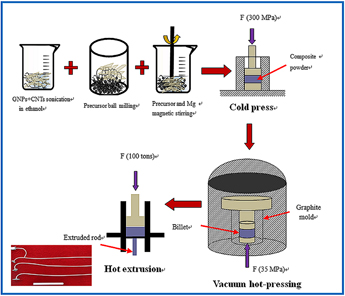Crossref Citations
This article has been cited by the following publications. This list is generated based on data provided by
Crossref.
Sun, Wen
Tan, Adrian Wei-Yee
Bhowmik, Ayan
Xue, Fei
Marinescu, Iulian
and
Liu, Erjia
2019.
Evaluation of cold sprayed graphene nanoplates–Inconel 718 composite coatings.
Surface and Coatings Technology,
Vol. 378,
Issue. ,
p.
125065.
Wu, Liqun
Wu, Ruizhi
Zhang, Jinghuai
Hou, Legan
and
Zhang, Milin
2019.
Synergistic effect of carbon nanotube and graphene nanoplatelet addition on microstructure and mechanical properties of AZ31 prepared using hot-pressing sintering – ERRATUM.
Journal of Materials Research,
Vol. 34,
Issue. 23,
p.
3975.
Ding, Yunpeng
Jiao, Sijia
Zhang, Yizhuang
Shi, Zhiai
Hu, Jinbiao
Wang, Xulei
Li, Zhiyuan
Wang, Hanying
and
Guo, Xiaoqin
2022.
Influence of Soft Phase and Carbon Nanotube Content on the Properties of Hierarchical AZ61 Matrix Composite with Isolated Soft Phase.
Nanomaterials,
Vol. 12,
Issue. 16,
p.
2877.
Ding, Yunpeng
Shi, Zhiai
Li, Zhiyuan
Jiao, Sijia
Hu, Jinbiao
Wang, Xulei
Zhang, Yizhuang
Wang, Hanying
and
Guo, Xiaoqin
2022.
Effect of CNT Content on Microstructure and Properties of CNTs/Refined-AZ61 Magnesium Matrix Composites.
Nanomaterials,
Vol. 12,
Issue. 14,
p.
2432.
Zhou, Mingyang
Gao, Shixin
Zhao, Yanli
Yang, Qingfeng
Liu, Xiaohui
Ren, Lingbao
Lyu, Liangliang
Quan, Gaofeng
and
Gupta, Manoj
2022.
Hybrid (Carbon Nanotube + Graphene Nanoplatelet)/AZ31 Composite with Simultaneously Enhanced Strength and Ductility.
Advanced Engineering Materials,
Vol. 24,
Issue. 3,
Alias, J.
Bakar, N. F. A.
Romzi, M. A. F.
Ramli, M. I. M.
and
Alang, N. A.
2022.
Enabling Industry 4.0 through Advances in Manufacturing and Materials.
p.
139.
Su, Qian
Han, Yejin
Yu, Huan
Zhang, Peng
Wang, Rongrong
Li, Hang
Zhou, Jixue
and
Hu, Lianxi
2023.
Effect of annealing treatment on the microstructure and mechanical properties of bulk nanostructured Ti/AZ61 composites prepared by hot pressing.
Journal of Materials Research and Technology,
Vol. 25,
Issue. ,
p.
1447.
Guadagno, Liberata
Naddeo, Carlo
Sorrentino, Andrea
and
Raimondo, Marialuigia
2023.
Thermo-Mechanical Performance of Epoxy Hybrid System Based on Carbon Nanotubes and Graphene Nanoparticles.
Nanomaterials,
Vol. 13,
Issue. 17,
p.
2427.
Xiong, JunJie
Liu, Zhibin
and
Yan, Hong
2023.
Effects of hot extrusion on the microstructure and mechanical properties of 2024Al-GNPs composites.
Diamond and Related Materials,
Vol. 131,
Issue. ,
p.
109551.
Pillari, Lava Kumar
Lessoway, Kyle
and
Bichler, Lukas
2023.
Carbon nanotube and graphene reinforced magnesium matrix composites: A state-of-the-art review.
Journal of Magnesium and Alloys,
Vol. 11,
Issue. 6,
p.
1825.
Ding, Yunpeng
Jiang, Haoju
Wang, Haitao
Mao, Dongxu
Zhang, Yizhuang
Chen, Zhanxing
and
Guo, Xiaoqin
2024.
Toughening and strengthening of Cu-coated carbon nanotubes reinforced AZ61 magnesium matrix nanocomposites by improving interfacial bonding.
Diamond and Related Materials,
Vol. 142,
Issue. ,
p.
110788.
Rahoomi, Zenaa R.
Ahmed, Duha S.
Jabir, Majid S.
Samir, Haney
Swelum, Ayman A.
and
Elzwawy, Amir
2024.
Modification of MWCNTs with Bi2WO6 nanoparticles targeting IL-1β and NLRP3 inflammasome via augmented autophagy.
PLOS ONE,
Vol. 19,
Issue. 10,
p.
e0309389.
Zhang, Jiahang
Li, Dongsheng
and
Wang, Mingming
2024.
Multi-material fused deposition modelling of structural–functional integrated absorber with multi-scale structure possessing tunable broadband microwave absorption.
Materials & Design,
Vol. 246,
Issue. ,
p.
113315.
Kamei, Shuhei
Hirayama, Tomoko
Somekawa, Hidetoshi
and
Matsuoka, Takashi
2024.
Improved wear and friction properties by self-formed SiC layers in Mg/SiC composites.
Ceramics International,
Vol. 50,
Issue. 17,
p.
30359.
Zhang, Jiahang
Li, Dongsheng
and
Wang, Mingming
2025.
3D printed polyetherimide-based multiscale structural-functional integrated absorber for broadband microwave absorption.
Additive Manufacturing,
Vol. 97,
Issue. ,
p.
104613.
Zhang, Jiahang
Li, Dongsheng
and
Wang, Mingming
2025.
Micro-screw extrusion 3D printing of multiscale ternary nanocomposite absorbers – Part I: Comprehensive materials characterization and exceptional microwave absorption performance.
Materials & Design,
Vol. 251,
Issue. ,
p.
113694.
Liu, Bo
Sun, Jialin
Zhao, Jun
and
Yun, Xialun
2025.
Hybrid graphene and carbon nanotube–reinforced composites: polymer, metal, and ceramic matrices.
Advanced Composites and Hybrid Materials,
Vol. 8,
Issue. 1,



